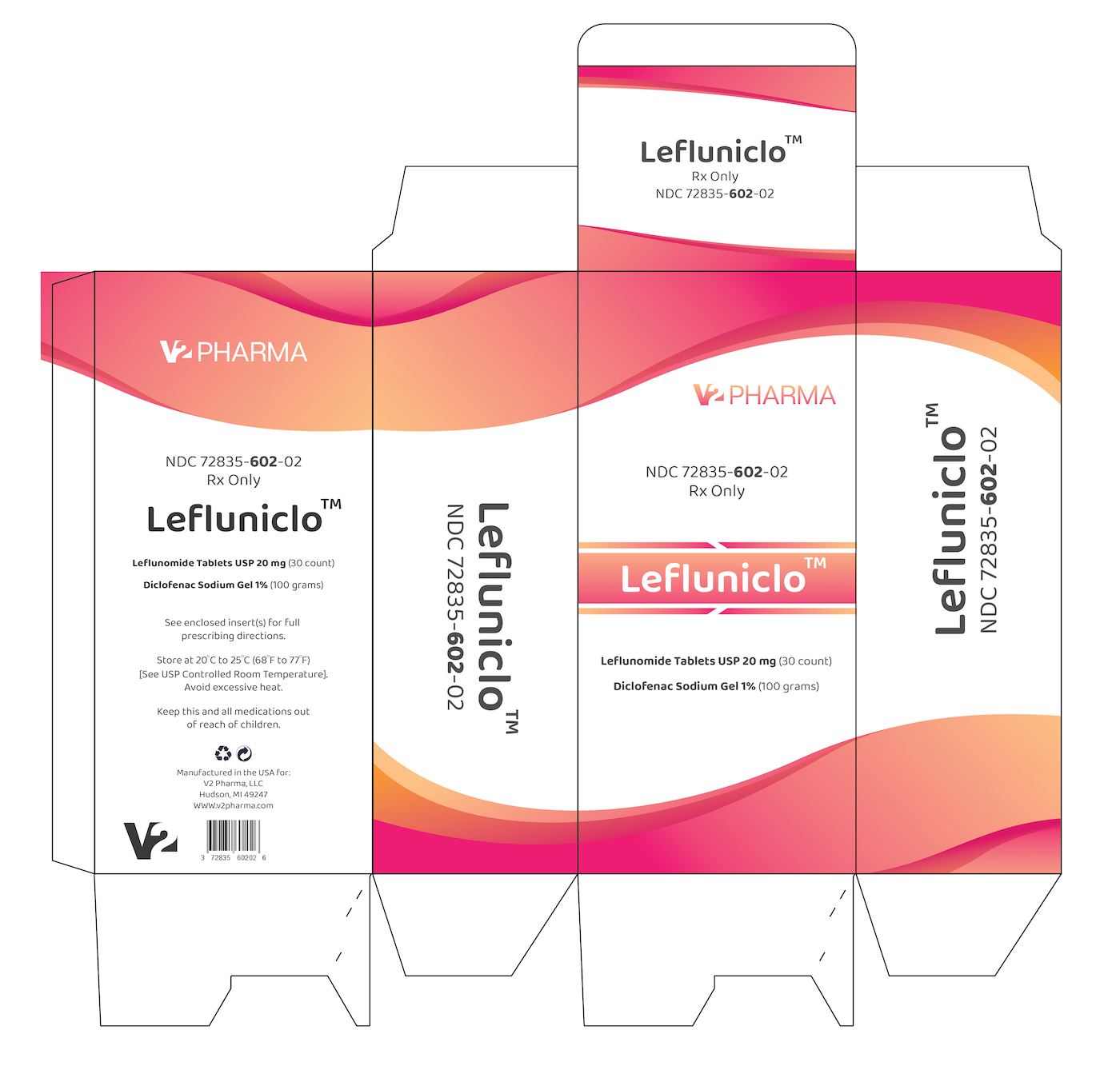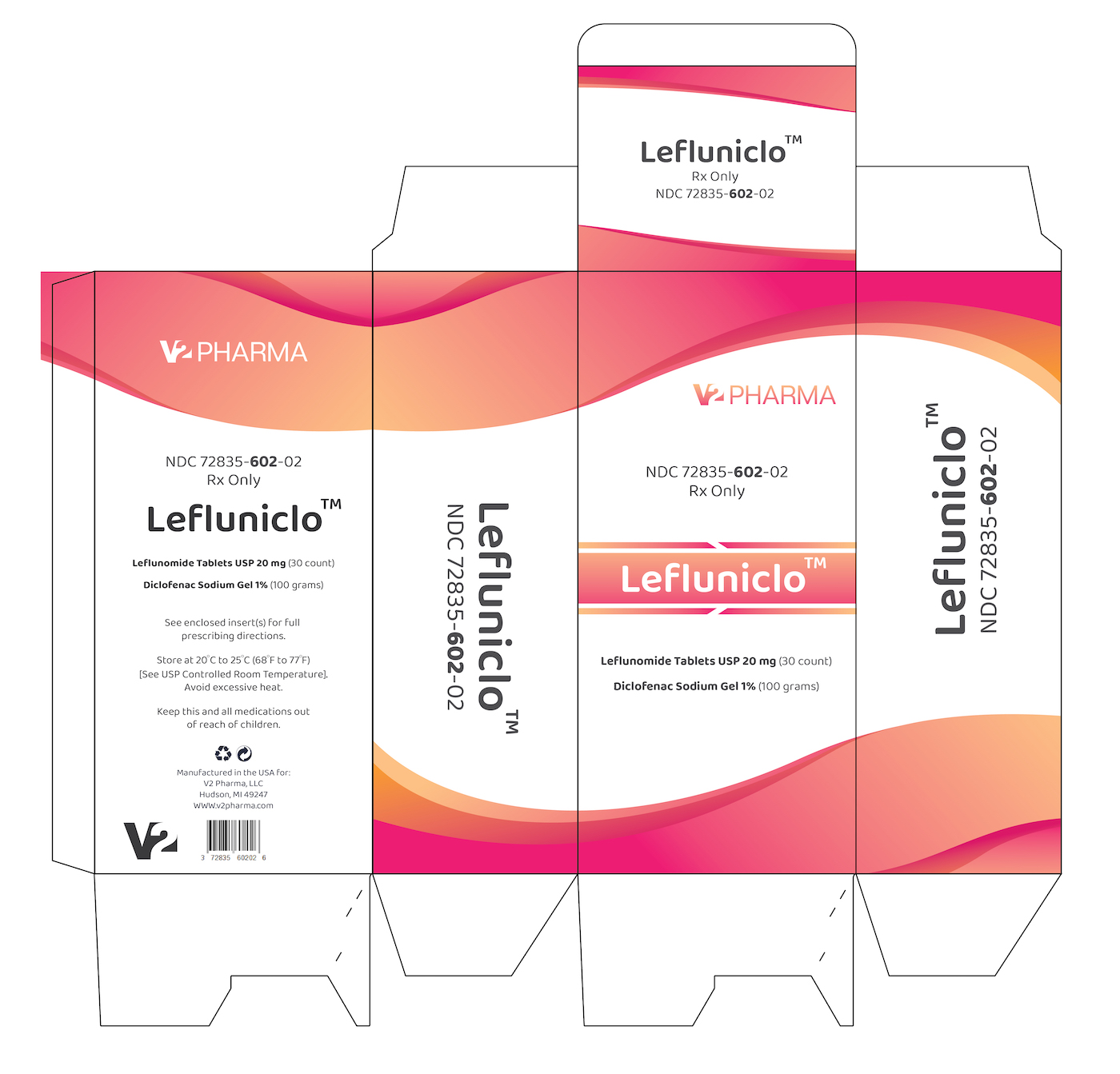Label: LEFLUNICLO- leflunomide and diclofenac sodium gel kit
- NDC Code(s): 0113-1189-01, 70748-130-06, 72835-602-02
- Packager: V2 Pharma, LLC
- Category: HUMAN PRESCRIPTION DRUG LABEL
- DEA Schedule: None
- Marketing Status: unapproved drug other
DISCLAIMER: This drug has not been found by FDA to be safe and effective, and this labeling has not been approved by FDA. For further information about unapproved drugs, click here.
Drug Label Information
Updated March 29, 2023
If you are a consumer or patient please visit this version.
- Download DRUG LABEL INFO: PDF XML
- Official Label (Printer Friendly)
-
HIGHLIGHTS OF PRESCRIBING INFORMATION
These highlights do not include all the information needed to use LEFLUNICLO safely and effectively. See full prescribing information for Lefluniclo
Lefluniclo
LEFLUNOMIDE Tablets, for oral use:
Initial U.S. Approval: 1998DOSAGE AND ADMINISTRATION
Loading dosage for patients at low risk for leflunomide tablets -associated hepatotoxicity and leflunomide tablets-associated myelosuppression: 100 mg daily for 3 days (2.1)
Maintenance dosage: 20 mg daily. (2.1)
Maximum recommended daily dosage: 20 mg once daily. (2.1)
If 20 mg once daily is not tolerated, may decrease dosage to 10 mg once daily. (2.1)
Screen patients for active and latent tuberculosis, pregnancy test (females), blood pressure, and laboratory tests before starting leflunomide tablets. (2.2) (12)CONTRAINDICATIONS
Pregnancy. (4, 5.1,8.1)
Severe hepatic impairment. (4,5.2)
Hypersensitivity to leflunomide tablets or any of its inactive components. (4)
Current teriflunomide treatment. (4) (14)WARNINGS AND PRECAUTIONS
- After stopping leflunomide tablets, it is recommended that an accelerated drug elimination procedure be used to reduce the plasma concentrations of the active metabolite, teriflunomide. (5.3)
- Severe infections (including sepsis), pancytopenia, agranulocytosis and thrombocytopenia: Stop leflunomide tablets and use accelerated elimination procedure. Do not start leflunomide tablets in patients with active infection. Monitor CBCs during treatment with leflunomide tablets (5.4)
- Stevens-Johnson syndrome and toxic epidermal necrolysis: Stop leflunomide tablets and use accelerated elimination procedure. (5.5)
- Peripheral neuropathy: If patient develops symptoms consistent with peripheral neuropathy, evaluate patient and consider discontinuing leflunomide tablets. (5.7)
- Interstitial lung disease: May be fatal. New onset or worsening symptoms may necessitate discontinuation of leflunomide tablets and initiation of accelerated elimination procedure. (5.8)
- Increased blood pressure: Monitor and treat. (5.10)
ADVERSE REACTIONS
The most commonly reported adverse reactions (≥10%) regardless of relation to leflunomide tablets treatment were diarrhea, respiratory infection, nausea, headache, rash, abnormal liver enzymes, dyspepsia. (6.1)
To report SUSPECTED ADVERSE REACTIONS, contact Lupin Pharmaceutical Inc. at 1-800-399-2561 or FDA at 1-800-FDA-1088 or www.fda.gov/medwatch (16)DRUG INTERACTIONS
Drugs metabolized by CYP2C8 and OAT3 transporters: Monitor patients because teriflunomide may increase exposure of these drugs. (7)
Teriflunomide may increase exposure of ethinylestradiol and levonorgestrel. Choose an appropriate oral contraceptive. (7)
Drugs metabolized by CYP1A2: Monitor patients because teriflunomide may decrease exposure of these drugs. (7)
Warfarin: Monitor INR as teriflunomide may decrease INR. (7)
Drugs metabolized by BCRP and OATP1B1/B3 transporters: Monitor patients because teriflunomide may increase exposure of these drugs. (7)
Rosuvastatin: The dose of rosuvastatin should not exceed 10 mg once daily in patients taking leflunomide tablets. (7) (17)USE IN SPECIFIC POPULATIONS
See 17 for PATIENT COUNSELING INFORMATION.
Revised: 3/2023
-
Table of Contents
FULL PRESCRIBING INFORMATION: CONTENTS*
LEFLUNICLO DESCRIPTION
INDICATION AND USAGE
DOSAGE AND ADMINISTRATION
CONTRADICTIONS
PRECAUTIONS
PREGNANCY
Leflunomide 20mg
WARNING: EMBRYO-FETAL TOXICITY and HEPATOTOXICITY
1 INDICATIONS AND USAGE
These highlights do not include all the information needed to use. See full prescribing information for and Initial U.S. Approval
"These highlights do not include all the information needed to use" "see full prescribing information for" and "Initial U.S. Approval"
2.1 Recommended Dosage
3 DOSAGE FORMS AND STRENGTHS
4 CONTRAINDICATIONS
5 WARNINGS AND PRECAUTIONS
5.1 Embryo-Fetal Toxicity
5.2 Hepatotoxicity
5.3 Procedure for Accelerated Elimination of leflunomide tablets and its Active Metabolite
5.4 Immunosuppression, Bone Marrow Suppression, and Risk of Serious Infections
5.5 Stevens-Johnson Syndrome, Toxic Epidermal Necrolysis, and Drug Reactions with Eosinophilia and Systemic Symptoms
5.6 Malignancy
5.7 Peripheral Neuropathy
5.8 Interstitial Lung Disease
5.9 Vaccinations
5.10 Blood Pressure Monitoring
6 ADVERSE REACTIONS
6.1 Clinical Trials Experience
7 DRUG INTERACTIONS
8 USE IN SPECIFIC POPULATIONS
8.1 Pregnancy
8.2 Lactation
8.3 Females and Males of Reproductive Potential
8.4 Pediatric Use
8.5 Geriatric Use
8.6 Hepatic Impairment
8.7 Renal Impairment
10 OVERDOSAGE
11 DESCRIPTION
12 CLINICAL PHARMACOLOGY
12.1 Mechanism of Action
12.3 Pharmacokinetics
13 NONCLINICAL TOXICOLOGY
13.1 Carcinogenesis, Mutagenesis, Impairment of Fertility
14 CLINICAL STUDIES
16 HOW SUPPLIED/STORAGE AND HANDLING
17 PATIENT COUNSELING INFORMATION
Do not use
Ask a doctor before use if
Ask a doctor or pharmacist before use if you are
When using this product
Stop use and ask a doctor if
If pregnant or breast-feeding,
Keep out of reach of children.
- *
- Sections or subsections omitted from the full prescribing information are not listed.
- SPL UNCLASSIFIED SECTION
- LEFLUNICLO DESCRIPTION
- INDICATION AND USAGE
-
DOSAGE AND ADMINISTRATION
SEE PRESCRIBING DIRECTIONS FOR EACH COMPONENT CONTAINED IN THIS KIT
Take one leflunimide 20 mg once daily. The maximum recommended daily dosage is 20 mg once per day.
Apply 2-4 grams of diclofenac 1% gel to treated area as needed up to 4 times per day. Do not usea on more than 2 body areas at the same time.
- CONTRADICTIONS
- PRECAUTIONS
- HOW SUPPLIED
- SPL UNCLASSIFIED SECTION
- Leflunomide 20mg
-
BOXED WARNING
(What is this?)
WARNING: EMBRYO-FETAL TOXICITY and HEPATOTOXICITY
Embryo-Fetal Toxicity
Leflunomide tablet is contraindicated for use in pregnant women because of the potential for fetal harm. Teratogenicity and embryo-lethality occurred in animals administered leflunomide at doses lower than the human exposure level. Exclude pregnancy before the start of treatment with leflunomide tablets in females of reproductive potential. Advise females of reproductive potential to use effective contraception during leflunomide tablets treatment and during an accelerated drug elimination procedure after leflunomide tablets treatment. Stop leflunomide tablets and use an accelerated drug elimination procedure if the patient becomes pregnant. [see Contraindications (4), Warnings and Precautions (5.1, 5.3), Use in Special Populations (8.1, 8.3)], and Clinical Pharmacology (12.3)]
Hepatotoxicity
Severe liver injury, including fatal liver failure, has been reported in patients treated with leflunomide tablets. Leflunomide tablet is contraindicated in patients with severe hepatic impairment. Concomitant use of leflunomide tablets with other potentially hepatotoxic drugs may increase the risk of liver injury. Patients with pre-existing acute or chronic liver disease, or those with serum alanine aminotransferase (ALT) >2xULN before initiating treatment, are at increased risk and should not be treated with leflunomide tablets. Monitor ALT levels at least monthly for six months after starting leflunomide tablets, and thereafter every 6 to 8 weeks. If leflunomide-induced liver injury is suspected, stop leflunomide tablets treatment, start an accelerated drug elimination procedure, and monitor liver tests weekly until normalized. [see Contraindications (4), Warnings and Precautions (5.2, 5.3), Use in Special Populations (8.6)] - 1 INDICATIONS AND USAGE
- These highlights do not include all the information needed to use. See full prescribing information for and Initial U.S. Approval
-
"These highlights do not include all the information needed to use" "see full prescribing information for" and "Initial U.S. Approval"
2.1 Recommended Dosage
The recommended dosage of leflunomide tablets USP is 20 mg once daily. Treatment may be initiated with or without a loading dose, depending upon the patient's risk of leflunomide tablets USP -associated hepatotoxicity and leflunomide tablets -associated myelosuppression. The loading dosage provides steady-state concentrations more rapidly.
For patients who are at low risk for leflunomide tablets -associated hepatotoxicity and leflunomide tablets USP - associated myelosuppression the recommended leflunomide tablets USP loading dosage is 100 mg once daily for 3 days. Subsequently administer 20 mg once daily.
For patients at high risk for leflunomide tablets USP -associated hepatotoxicity (e.g., those taking concomitant methotrexate) or leflunomide tablets -associated myelosuppression (e.g., patients taking concomitant immunosuppressants), the recommended leflunomide tablets USP dosage is 20 mg once daily without a loading dose [see Warnings and Precautions (5.2,5.4)].
The maximum recommended daily dosage is 20 mg once per day. Consider dosage reduction to 10 mg once daily for patients who are not able to tolerate 20 mg daily (i.e., for patients who experience any adverse events listed in Table 1).Monitor patients carefully after dosage reduction and after stopping therapy with leflunomide tablets, since the active metabolite of leflunomide, teriflunomide, is slowly eliminated from the plasma [see Clinical Pharmacology (12.3)]. After stopping leflunomide tablets treatment, an accelerated drug elimination procedure is recommended to reduce the plasma concentrations of the active metabolite, teriflunomide [see Warnings and Precautions (5.3)]. Without use of an accelerated drug elimination procedure, it may take up to 2 years to reach undetectable plasma teriflunomide concentrations after stopping leflunomide tablets [see Clinical Pharmacology (12.3)].
- 3 DOSAGE FORMS AND STRENGTHS
-
4 CONTRAINDICATIONS
Leflunomide tablet is contraindicated in:
Pregnant women. Leflunomide tablets may cause fetal harm. If a woman becomes pregnant while taking this drug, stop leflunomide tablets, apprise the patient of the potential hazard to the fetus, and begin a drug elimination procedure [see Warnings and Precautions (5.1 and 5.3) and Use in Specific Populations (8.1)].
Patients with severe hepatic impairment [see Warnings and Precautions (5.2)].
Patients with known hypersensitivity to leflunomide or any of the other components of leflunomide tablets. Known reactions include anaphylaxis [see Adverse Reactions (6.1)].
Patients being treated with teriflunomide [see Drug Interactions (7)]. -
5 WARNINGS AND PRECAUTIONS
5.1 Embryo-Fetal Toxicity
Leflunomide tablets may cause fetal harm when administered to a pregnant woman. Teratogenicity and embryo-lethality occurred in animal reproduction studies with leflunomide at doses lower than the human exposure level [see Use in Specific Populations (8.1)].
Leflunomide tablet is contraindicated for use in pregnant women [see Contraindications (4)]. Exclude pregnancy before starting treatment with leflunomide tablets in females of reproductive potential [see Dosage and Administration (2.2)]. Advise females of reproductive potential to use effective contraception during leflunomide tablets treatment and during an accelerated drug elimination procedure after leflunomide tablets treatment [see Use in Specific Populations (8.3)]. If a woman becomes pregnant while taking leflunomide tablets, stop treatment with leflunomide tablets, apprise the patient of the potential risk to a fetus, and perform an accelerated drug elimination procedure to achieve non-detectable plasma concentrations of teriflunomide, the active metabolite of leflunomide [see Warnings and Precautions (5.3)].
Upon discontinuing leflunomide tablets, it is recommended that all females of reproductive potential undergo an accelerated drug elimination procedure. Women receiving leflunomide tablets treatment who wish to become pregnant must discontinue leflunomide tablets and undergo an accelerated drug elimination procedure, which includes verification that plasma concentrations of the active metabolite of leflunomide, teriflunomide, are less than 0.02 mg/L (0.02 mcg/mL). Based on animal data, human plasma concentrations of teriflunomide of less than 0.02 mg/L (0.02 mcg/mL) are expected to have minimal embryo-fetal risk [see Contraindications (4), Warnings and Precautions (5.3), and Use in Specific Populations (8.1)].5.2 Hepatotoxicity
Severe liver injury, including fatal liver failure, has been reported in some patients treated with leflunomide tablets. Patients with pre-existing acute or chronic liver disease, or those with serum alanine aminotransferase (ALT) of greater than twice the upper limits of normal (>2xULN) before initiating treatment, should not be treated with leflunomide tablets. Use caution when leflunomide tablets are given with other potentially hepatotoxic drugs. Monitoring of ALT levels is recommended at least monthly for six months after starting leflunomide tablets, and thereafter every 6 to 8 weeks. If ALT elevation > 3 fold ULN occurs, interrupt leflunomide tablets therapy and investigate the cause. If likely leflunomide tablets - induced, perform the accelerated drug elimination procedure and monitor liver tests weekly until normalized [see Warnings and Precautions (5.3)]. If leflunomide tablets -induced liver injury is unlikely because some other cause has been found, resumption of leflunomide tablets therapy may be considered. If leflunomide tablets and methotrexate are given concomitantly, follow the American College of Rheumatology (ACR) guidelines for monitoring methotrexate liver toxicity with ALT, AST, and serum albumin testing.
5.3 Procedure for Accelerated Elimination of leflunomide tablets and its Active Metabolite
The active metabolite of leflunomide, teriflunomide, is eliminated slowly from the plasma [see Clinical Pharmacology (12.3)].
Use of an accelerated drug elimination procedure will rapidly reduce plasma concentrations of leflunomide and its active metabolite, teriflunomide. Therefore, an accelerated elimination procedure should be considered at any time after discontinuation of leflunomide tablets, and in particular, when a patient has experienced a severe adverse reaction (e.g., hepatotoxicity, serious infection, bone marrow suppression, Steven Johnson Syndrome, toxic epidermal necrolysis, peripheral neuropathy, interstitial lung disease), suspected hypersensitivity, or has become pregnant. It is recommended that all women of childbearing potential undergo an accelerated elimination procedure after stopping leflunomide tablets treatment.
Without use of an accelerated drug elimination procedure, it may take up to 2 years to reach plasma teriflunomide concentrations of less than 0.02 mg/L, the plasma concentration not associated with embryo-fetal toxicity in animals.
Elimination can be accelerated by the following procedures:
Administer cholestyramine 8 grams orally 3 times daily for 11 days.
Alternatively, administer 50 grams of activated charcoal powder (made into a suspension) orally every 12 hours for 11 days.
Verify plasma teriflunomide concentrations of less than 0.02 mg/L (0.02 µg/mL) by two separate tests at least 14 days apart. If plasma teriflunomide concentrations are higher than 0.02 mg/L, repeat cholestyramine and/or activated charcoal treatment.
The duration of accelerated drug elimination treatment may be modified based on the clinical status and tolerability of the elimination procedure. The procedure may be repeated as needed, based on teriflunomide concentrations and clinical status.
Use of the accelerated drug elimination procedure may potentially result in return of disease activity if the patient had been responding to leflunomide tablets treatment.5.4 Immunosuppression, Bone Marrow Suppression, and Risk of Serious Infections
Leflunomide tablets are not recommended for patients with severe immunodeficiency, bone marrow dysplasia, or severe, uncontrolled infections. If a serious infection occurs, consider interrupting leflunomide tablets therapy and initiating the accelerated drug elimination procedure [see Warnings and Precautions (5.3)]. Medications like leflunomide tablets that have immunosuppression potential may cause patients to be more susceptible to infections, including opportunistic infections, especially Pneumocystis jiroveci pneumonia, tuberculosis (including extra-pulmonary tuberculosis), and aspergillosis. Severe infections including sepsis, which may be fatal, have been reported in patients receiving leflunomide tablets, especially Pneumocystis jiroveci pneumonia and aspergillosis. Most of the reports were confounded by concomitant immunosuppressant therapy and/or comorbid illness which, in addition to rheumatoid arthritis, may predispose patients to infection.
Cases of tuberculosis were observed in clinical studies with teriflunomide, the metabolite of leflunomide tablets. Prior to initiating leflunomide tablets, all patients should be screened for active and inactive ("latent") tuberculosis infection as per commonly used diagnostic tests. Leflunomide tablets has not been studied in patients with a positive tuberculosis screen, and the safety of leflunomide tablets in individuals with latent tuberculosis infection is unknown. Patients testing positive in tuberculosis screening should be treated by standard medical practice prior to therapy with leflunomide tablets and monitored carefully during leflunomide tablets treatment for possible reactivation of the infection.
Pancytopenia, agranulocytosis and thrombocytopenia have been reported in patients receiving leflunomide tablets alone. These events have been reported most frequently in patients who received concomitant treatment with methotrexate or other immunosuppressive agents, or who had recently discontinued these therapies; in some cases, patients had a prior history of a significant hematologic abnormality.
Patients taking leflunomide tablets should have platelet, white blood cell count and hemoglobin or hematocrit monitored at baseline and monthly for six months following initiation of therapy and every 6 to 8 weeks thereafter. If used with concomitant methotrexate and/or other potential immunosuppressive agents, chronic monitoring should be monthly. If evidence of bone marrow suppression occurs in a patient taking leflunomide tablets, stop treatment with leflunomide tablets, and perform an accelerated drug elimination procedure to reduce the plasma concentration of the leflunomide tablets active metabolite, teriflunomide [see Warnings and Precautions (5.3)].
In any situation in which the decision is made to switch from leflunomide tablets to another anti-rheumatic agent with a known potential for hematologic suppression, it would be prudent to monitor for hematologic toxicity, because there will be overlap of systemic exposure to both compounds.5.5 Stevens-Johnson Syndrome, Toxic Epidermal Necrolysis, and Drug Reactions with Eosinophilia and Systemic Symptoms
Rare cases of Stevens-Johnson syndrome and toxic epidermal necrolysis, and drug reaction with eosinophilia and systemic symptoms (DRESS) have been reported in patients receiving leflunomide tablets. If a patient taking leflunomide tablets develops any of these conditions, stop leflunomide tablets treatment and perform an accelerated drug elimination procedure [see Warnings and Precautions (5.3)].
5.6 Malignancy
The risk of malignancy, particularly lymphoproliferative disorders, is increased with the use of some immunosuppression medications. There is a potential for immunosuppression with leflunomide tablets. No apparent increase in the incidence of malignancies and lymphoproliferative disorders was reported in the clinical trials of leflunomide tablets, but larger dosages and longer-term studies would be needed to determine whether there is an increased risk of malignancy or lymphoproliferative disorders with leflunomide tablets.
5.7 Peripheral Neuropathy
Cases of peripheral neuropathy have been reported in patients receiving leflunomide tablets and in clinical studies with teriflunomide, the active metabolite of leflunomide. Most patients recovered after discontinuation of treatment, but some patients had persistent symptoms. Age older than 60 years, concomitant neurotoxic medications, and diabetes may increase the risk for peripheral neuropathy. If a patient taking leflunomide tablets develops a peripheral neuropathy, consider discontinuing leflunomide tablets therapy and performing an accelerated drug elimination procedure [see Dosage and Administration (5.3)].
5.8 Interstitial Lung Disease
Interstitial lung disease and worsening of pre-existing interstitial lung disease have been reported during treatment with leflunomide tablets and has been associated with fatal outcomes [see Adverse Reactions (6.2)]. The risk of leflunomide tablets -associated interstitial lung disease is increased in patients with a history of interstitial lung disease. Interstitial lung disease is a potentially fatal disorder that may occur acutely at any time during therapy and has a variable clinical presentation. New onset or worsening pulmonary symptoms, such as cough and dyspnea, with or without associated fever, may be a reason for discontinuation of leflunomide tablets therapy and for further investigation as appropriate. If discontinuation of leflunomide tablet is necessary, consider performing an accelerated drug elimination procedure [see Warnings and Precautions (5.3)].
5.9 Vaccinations
No clinical data are available on the efficacy and safety of vaccinations during leflunomide tablets treatment. Vaccination with live vaccines is, however, not recommended. The long half-life of the active metabolite of leflunomide tablets should be considered when contemplating administration of a live vaccine after stopping leflunomide tablets.
5.10 Blood Pressure Monitoring
In placebo-controlled studies with the active metabolite of leflunomide tablets, teriflunomide, elevations in blood pressure were observed in some subjects. Blood pressure should be checked before starting treatment with leflunomide tablets and monitored periodically thereafter [See Adverse Reactions (6.1)].
-
6 ADVERSE REACTIONS
The following serious adverse reactions are described elsewhere in the labeling:
Hepatotoxicity [see Warnings and Precautions (5.2)]
Immunosuppression [see Warnings and Precautions (5.4)]
Bone marrow suppression [see Warnings and Precautions (5.4)]
Stevens-Johnson syndrome and toxic epidermal necrolysis [see Warnings and Precautions (5.5)]
Peripheral neuropathy [see Warnings and Precautions (5.7 )]
Interstitial lung disease [see Warnings and Precautions (5.8)]6.1 Clinical Trials Experience
Because clinical studies are conducted under widely varying conditions, adverse reaction rates observed in the clinical studies of a drug cannot be directly compared to rates in the clinical studies of another drug and may not reflect the rates observed in practice.
In clinical studies (Trials 1, 2, and 3), 1,865 patients were treated with leflunomide tablets administered as either monotherapy or in combination with methotrexate or sulfasalazine. Patients ranged in age from 19 to 85 years, with an overall median age of 58 years. The mean duration of RA was 6 years ranging from 0 to 45 years.
Elevation of Liver Enzymes
Treatment with leflunomide tablets was associated with elevations of liver enzymes, primarily ALT and AST, in a significant number of patients; these effects were generally reversible. Most transaminase elevations were mild (≤ 2-fold ULN) and usually resolved while continuing treatment. Marked elevations (>3-fold ULN) occurred infrequently and reversed with dose reduction or discontinuation of treatment. Table 1 shows liver enzyme elevations seen with monthly monitoring in clinical trials Trial 1 and Trial 2. It was notable that the absence of folate use in Trial 3 was associated with a considerably greater incidence of liver enzyme elevation on methotrexate.In a 6 month study of 263 patients with persistent active rheumatoid arthritis despite methotrexate therapy, and with normal LFTs, leflunomide tablets was administered to a group of 130 patients starting at 10 mg per day and increased to 20 mg as needed. An increase in ALT greater than or equal to three times the ULN was observed in 3.8% of patients compared to 0.8% in 133 patients continued on methotrexate with placebo.
Most Common Adverse Reactions
The most common adverse reactions in leflunomide tablets -treated patients with RA include diarrhea, elevated liver enzymes (ALT and AST), alopecia and rash. Table 2 displays the most common adverse reactions in the controlled studies in patients with RA at one year (≥ 5% in any leflunomide tablets treatment group).
Adverse events during a second year of treatment with leflunomide tablets in clinical trials were consistent with those observed during the first year of treatment and occurred at a similar or lower incidence.
Less Common Adverse Reactions
In addition, in controlled clinical trials, the following adverse events in the leflunomide tablets treatment group occurred at a higher incidence than in the placebo group. These adverse events were deemed possibly related to the study drug.
Blood and Lymphatic System: leukocytosis, thrombocytopenia;
Cardiovascular: chest pain, palpitation, thrombophlebitis of the leg, varicose vein;
Eye: blurred vision, eye disorder, papilledema, retinal disorder, retinal hemorrhage;
Gastrointestinal: alkaline phosphatase increased, anorexia, bilirubinemia, flatulence, gamma-GT increased, salivary gland enlarged, sore throat, vomiting, dry mouth;
General Disorders: malaise;
Immune System: anaphylactic reaction;
Infection: abscess, flu syndrome, vaginal moniliasis;
Nervous System: dizziness, headache, somnolence;
Respiratory System: dyspnea; -
7 DRUG INTERACTIONS
Following oral administration, leflunomide is metabolized to an active metabolite, teriflunomide, which is responsible for essentially all of leflunomide's in vivo activity. Drug interaction studies have been conducted with both leflunomide and with its active metabolite, teriflunomide, where the metabolite was directly administered to the test subjects.
Effect of potent CYP and transporter inducers
Leflunomide is metabolized by CYP450 metabolizing enzymes. Concomitant use of leflunomide tablets and rifampin, a potent inducer of CYP and transporters, increased the plasma concentration of teriflunomide by 40%. However, when co-administered with the metabolite, teriflunomide, rifampin did not affect its pharmacokinetics. No dosage adjustment is recommended for leflunomide tablets when coadministered with rifampin. Because of the potential for leflunomide tablets concentrations to continue to increase with multiple dosing, caution should be used if patients are to be receiving both leflunomide tablets and rifampin [see Clinical Pharmacology (12.3)].Effect on CYP2C8 substrates
Teriflunomide is an inhibitor of CYP2C8 in vivo. In patients taking leflunomide tablets, exposure of drugs metabolized by CYP2C8 (e.g., paclitaxel, pioglitazone, repaglinide, rosiglitazone) may be increased. Monitor these patients and adjust the dose of the concomitant drug(s) metabolized by CYP2C8 as required [see Clinical Pharmacology (12.3)].
Effect on warfarin
Coadministration of leflunomide tablets with warfarin requires close monitoring of the international normalized ratio (INR) because teriflunomide, the active metabolite of leflunomide tablets, may decrease peak INR by approximately 25%.
Effect on oral contraceptives
Teriflunomide may increase the systemic exposures of ethinylestradiol and levonorgestrel. Consideration should be given to the type or dose of contraceptives used in combination with leflunomide tablets [see Clinical Pharmacology (12.3)].
Effect on CYP1A2 substrates
Teriflunomide, the active metabolite of leflunomide tablets, may be a weak inducer of CYP1A2 in vivo. In patients taking leflunomide tablets, exposure of drugs metabolized by CYP1A2 (e.g., alosetron, duloxetine, theophylline, tizanidine) may be reduced. Monitor these patients and adjust the dose of the concomitant drug(s) metabolized by CYP1A2 as required [see Clinical Pharmacology (12.3)].
Effect on organic anion transporter 3 (OAT3) substrates
Teriflunomide inhibits the activity of OAT3 in vivo. In patients taking leflunomide tablets, exposure of drugs which are OAT3 substrates (e.g., cefaclor, cimetidine, ciprofloxacin, penicillin G, ketoprofen, furosemide, methotrexate, zidovudine) may be increased. Monitor these patients and adjust the dose of the concomitant drug(s) which are OAT3 substrates as required [see Clinical Pharmacology (12.3)].
Effect on BCRP and organic anion transporting polypeptide B1 and B3 (OATP1B1/1B3) substrates
Teriflunomide inhibits the activity of BCRP and OATP1B1/1B3 in vivo. For a patient taking leflunomide tablets, the dose of rosuvastatin should not exceed 10 mg once daily. For other substrates of BCRP (e.g., mitoxantrone) and drugs in the OATP family (e.g., methotrexate, rifampin), especially HMG- Co reductase inhibitors (e.g., atorvastatin, nateglinide, pravastatin, repaglinide, and simvastatin), consider reducing the dose of these drugs and monitor patients closely for signs and symptoms of increased exposures to the drugs while patients are taking leflunomide tablets [see Clinical Pharmacology (12.3)]. -
8 USE IN SPECIFIC POPULATIONS
8.1 Pregnancy
Leflunomide tablet is contraindicated for use in pregnant women because of the potential for fetal harm. In animal reproduction studies, oral administration of leflunomide during organogenesis at a dose of 1/10 of and equivalent to the maximum recommended human dose (MRHD) based on AUC, respectively in rats and rabbits, caused teratogenicity (rats and rabbits) and embryo-lethality (rats) [see Data]. Pregnancy exposure registry data are not available at this time to inform the presence or absence of drug-associated risk with the use of leflunomide tablets during pregnancy. The background risk of major birth defects and miscarriage for the indicated populations is unknown. The background risk in the U.S. general population of major birth defects is 2 to 4% and of miscarriage is 15 to 20% of clinically recognized pregnancies. If this drug is used during pregnancy, or if the patient becomes pregnant while taking this drug, stop treatment with leflunomide tablets, apprise the patient of the potential hazard to a fetus, and perform the accelerated drug elimination procedure to achieve teriflunomide concentrations of less than 0.02 mg/L (0.02 mcg/mL) [see Warnings and Precautions (5.3)].
Clinical Considerations
Fetal/Neonatal adverse reactions
Lowering the plasma concentration of the active metabolite, teriflunomide, by instituting an accelerated drug elimination procedure as soon as pregnancy is detected may decrease the risk to the fetus from leflunomide tablets. The accelerated drug elimination procedure includes verification that the plasma teriflunomide concentration is less than 0.02 mg/L. [see Warnings and Precautions (5.3) and Clinical Pharmacology (12.3)].
Data
Animal Data
In an embryofetal development study, pregnant rats administered leflunomide during organogenesis from gestation days 7 to 19 at a dose approximately 1/10 of the MRHD (on an AUC basis at a maternal oral dose of 15 mg/kg),teratogenic effects, most notably anophthalmia or microophthalmia and internal hydrocephalus, were observed. Under these exposure conditions, Leflunomide also caused a decrease in the maternal body weight and an increase in embryolethality with a decrease in fetal body weight for surviving fetuses. In an embryofetal development study, pregnant rabbits administered leflunomide during organogenesis from gestation days 6 to 18 at a dose approximately equivalent to the MRHD (on an AUC basis at a maternal oral dose of 10 mg/kg), a teratogenic finding of fused, dysplastic sternebrae was observed. Leflunomide was not teratogenic in rats and rabbits at doses approximately 1/150 and 1/10 of the MRHD, respectively (on an AUC basis at maternal oral dose of 1 mg/kg in both rats and rabbits).
In a pre- and post-natal development study, when female rats were treated leflunomide at a dose that was approximately 1/100 of the MRHD (on an AUC basis at a maternal dose of 1.25 mg/kg) beginning 14 days before mating and continuing until the end of lactation, the offspring exhibited marked (greater than 90%) decreases in postnatal survival.
8.2 Lactation
Clinical lactation studies have not been conducted to assess the presence of leflunomide tablets in human milk, the effects of leflunomide tablets on the breastfed child, or the effects of leflunomide tablets on milk production. Because of the potential for serious adverse reactions in a breastfed infant from leflunomide tablets, advise a nursing woman to discontinue breastfeeding during treatment with leflunomide tablets.
8.3 Females and Males of Reproductive Potential
Leflunomide tablets may cause fetal harm when administered during pregnancy. Advise females of the potential risk to the fetus. Advise females to notify their healthcare provider immediately if pregnancy occurs or is suspected during treatment [see Use in Specific Populations (8.1)]. Women receiving leflunomide tablets treatment who wish to become pregnant should discontinue leflunomide tablets and undergo an accelerated drug elimination procedure to achieve plasma teriflunomide concentrations of less than 0.02 mg/L (0.02 mcg/mL) [see Warnings and Precautions (5.3)].
Pregnancy Testing
Exclude pregnancy in females of reproductive potential before starting treatment with leflunomide tablets.
Contraception
Females
Advise females of reproductive potential to use effective contraception during treatment with leflunomide tablets and while undergoing a drug elimination procedure until verification that the plasma teriflunomide concentration is less than 0.02 mg/L [see Warnings and Precautions (5.3)].
8.4 Pediatric Use
The safety and effectiveness of leflunomide tablets in pediatric patients have not been established.
The safety and effectiveness of leflunomide tablets in the treatment of polyarticular course juvenile idiopathic arthritis (JIA) was evaluated in a single multicenter, double-blind, active-controlled trial in 94 pediatric patients (1:1 randomization) with polyarticular course juvenile idiopathic arthritis (JIA) as defined by the American College of Rheumatology (ACR). In this population, leflunomide tablets treatment was found not to be effective.
The safety of leflunomide tablets was studied in 74 patients with polyarticular course JIA ranging in age from 3 to 17 years (47 patients from the active-controlled study and 27 from an open-label safety and pharmacokinetic study). The most common adverse events included abdominal pain, diarrhea, nausea, vomiting, oral ulcers, upper respiratory tract infections, alopecia, rash, headache, and dizziness. Less common adverse events included anemia, hypertension, and weight loss. Fourteen pediatric patients experienced ALT and/or AST elevations, nine between 1.2 and 3-fold the upper limit of normal, five between 3 and 8-fold the upper limit of normal.
8.5 Geriatric Use
Of the total number of subjects in controlled clinical trials (Trials 1, 2, and 3) of leflunomide tablets, 234 subjects were 65 years and over [see Clinical Studies (14)]. No overall differences in safety or effectiveness were observed between these subjects and younger subjects, and other reported clinical experience has not identified differences in responses between the elderly and younger patients, but greater sensitivity of some older individuals cannot be ruled out. No dosage adjustment is needed in patients over 65.
8.6 Hepatic Impairment
Dedicated studies of the effect of hepatic impairment on leflunomide pharmacokinetics have not been conducted. Given the need to metabolize leflunomide into the active species, the role of the liver in drug elimination/recycling, and the possible risk of increased hepatic toxicity, the use of leflunomide tablets in patients with hepatic impairment is not recommended.
-
10 OVERDOSAGE
There have been reports of chronic overdose in patients taking leflunomide tablets at daily dose up to five times the recommended daily dose and reports of acute overdose in adults and children. Adverse events were consistent with the safety profile for leflunomide tablets [See Adverse Reactions (6)]. The most frequent adverse events observed were diarrhea, abdominal pain, leukopenia, anemia and elevated liver function tests.
In the event of a significant overdose or toxicity, perform an accelerated drug elimination procedure to accelerate elimination [see Warnings and Precautions (5.3)].
Studies with both hemodialysis and CAPD (chronic ambulatory peritoneal dialysis) indicate that teriflunomide, the primary metabolite of leflunomide, is not dialyzable [See Clinical Pharmacology (12.3)].
-
11 DESCRIPTION
Leflunomide USP is a pyrimidine synthesis inhibitor. The chemical name for leflunomide is N-(4´-trifluoromethylphenyl)-5-methylisoxazole-4-carboxamide. It has an empirical formula C12H9F3N2O2, a molecular weight of 270.2 and the following structural formula:
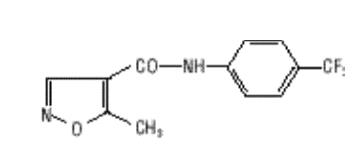
Leflunomide USP is available for oral administration as film coated tablets containing 10, 20 mg of active drug. Combined with leflunomide are the following inactive ingredients: colloidal silicon dioxide, crospovidone, hypromellose, lactose monohydrate, magnesium stearate, corn starch, HPMC 2910/Hypromellose USP (6 mPas), Titanium Dioxide USP, Macrogol/PEG 6000 NF, Talc USP and Iron Oxide Yellow NF (20 mg tablet only).
-
12 CLINICAL PHARMACOLOGY
12.1 Mechanism of Action
Leflunomide is an isoxazole immunomodulatory agent that inhibits dihydroorotate dehydrogenase (a mitochondrial enzyme involved in de novo pyrimidine synthesis) and has antiproliferative activity. Several in vivo and in vitro experimental models have demonstrated an anti-inflammatory effect.
12.3 Pharmacokinetics
Following oral administration, leflunomide is metabolized to an active metabolite, teriflunomide, which is responsible for essentially all of leflunomide's in vivo activity. Plasma concentrations of the parent drug, leflunomide, have been occasionally seen at very low concentrations. Studies of the pharmacokinetics of leflunomide have primarily examined the plasma concentrations of the active metabolite, teriflunomide.
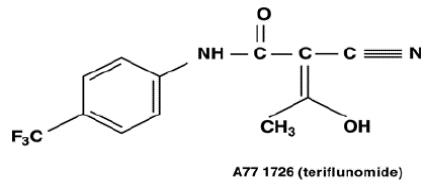
Following oral administration, peak teriflunomide concentrations occurred between 6 to 12 hours after dosing. Due to the very long half-life of teriflunomide (18 to 19 days), a loading dose of 100 mg for 3 days was used in clinical studies to facilitate the rapid attainment of steady-state teriflunomide concentrations. Without a loading dose, it is estimated that attainment of steady- state plasma concentrations would require about two months of dosing. The resulting plasma concentrations following both loading doses and continued clinical dosing indicate that plasma teriflunomide concentrations are dose proportional.
Effect of Food
Co-administration of leflunomide tablets with a high fat meal did not have a significant impact on teriflunomide plasma concentrations.
Distribution
Teriflunomide is extensively bound to plasma protein (>99%) and is mainly distributed in plasma. The volume of distribution is 11 L after a single intravenous (IV) administration.
Elimination
Teriflunomide, the active metabolite of leflunomide, has a median half-life of 18 to 19 days in healthy volunteers. The elimination of teriflunomide can be accelerated by administration of cholestyramine or activated charcoal. Without use of an accelerated drug elimination procedure, it may take up to 2 years to reach plasma teriflunomide concentrations of less than 0.02 mg/L, due to individual variation in drug clearance [see Warnings and Precautions (5.3)]. After a single IV administration of the metabolite (teriflunomide), the total body clearance of teriflunomide was 30.5 mL/h.
Metabolism
In vitro inhibition studies in human liver microsomes suggest that cytochrome P450 (CYP) 1A2, 2C19 and 3A4 are involved in leflunomide metabolism. In vivo, leflunomide is metabolized to one primary (teriflunomide) and many minor metabolites. In vitro, teriflunomide is not metabolized by CYP450 or flavin monoamine oxidase enzymes. The parent compound is rarely detectable in plasma.
Excretion
Teriflunomide, the active metabolite of leflunomide, is eliminated by direct biliary excretion of unchanged drug as well as renal excretion of metabolites. Over 21 days, 60.1% of the administered dose is excreted via feces (37.5%) and urine (22.6%). After an accelerated elimination procedure with cholestyramine, an additional 23.1% was recovered (mostly in feces).
Studies with both hemodialysis and CAPD (chronic ambulatory peritoneal dialysis) indicate that teriflunomide is not dialyzable.
Specific Populations
Gender. Gender has not been shown to cause a consistent change in the in vivo pharmacokinetics of teriflunomide.
Smoking. A population based pharmacokinetic analysis of the clinical trial data indicates that smokers have a 38% increase in clearance over non-smokers; however, no difference in clinical efficacy was seen between smokers and nonsmokers.
Drug Interaction Studies
Drug interaction studies have been conducted with both leflunomide and with its active metabolite, teriflunomide, where the metabolite was directly administered to the test subjects.
The Potential Effect of Other Drugs on Leflunomide tablets
- Potent CYP and transporter inducers:
Following concomitant administration of a single dose of leflunomide tablets to subjects receiving multiple doses of rifampin, teriflunomide peak concentrations were increased (~40%) over those seen when leflunomide tablets was given alone [see Drug Interactions (7)].
- An in vivo interaction study with leflunomide tablets and cimetidine (non-specific weak CYP inhibitor) has demonstrated a lack of a significant impact on teriflunomide exposure.
The Potential Effect of leflunomide tablets on Other Drugs
- CYP2C8 Substrates
There was an increase in mean repaglinide Cmax and AUC (1.7-and 2.4-fold, respectively), following repeated doses of teriflunomide and a single dose of 0.25 mg repaglinide, suggesting that teriflunomide is an inhibitor of CYP2C8 in vivo. The magnitude of interaction could be higher at the recommended repaglinide dose [see Drug Interactions (7)].
- CYP1A2 Substrates
Repeated doses of teriflunomide decreased mean Cmax and AUC of caffeine by 18% and 55%, respectively, suggesting that teriflunomide may be a weak inducer of CYP1A2 in vivo.
- OAT3 Substrates
There was an increase in mean cefaclor Cmax and AUC (1.43-and 1.54-fold, respectively), following repeated doses of teriflunomide, suggesting that teriflunomide is an inhibitor of organic anion transporter 3 (OAT3) in vivo [see Drug Interactions (7)]
- BCRP and OATP1B1/1B3 Substrates
There was an increase in mean rosuvastatin Cmax and AUC (2.65-and 2.51-fold, respectively), following repeated doses of teriflunomide, suggesting that teriflunomide is an inhibitor of BCRP transporter and organic anion transporting polypeptide 1B1 and 1B3 (OATP1B1/1B3) [see Drug Interactions (7)].
- Oral Contraceptives
There was an increase in mean ethinylestradiol Cmax and AUC0 to 24 (1.58-and 1.54-fold, respectively) and levonorgestrel Cmax and AUC0 to 24 (1.33-and 1.41-fold, respectively) following repeated doses of teriflunomide [see Drug Interactions (7)].
- Teriflunomide did not affect the pharmacokinetics of bupropion (a CYP2B6 substrate), midazolam (a CYP3A4 substrate), S-warfarin (a CYP2C9 substrate), omeprazole (a CYP2C19 substrate), and metoprolol (a CYP2D6 substrate).
-
13 NONCLINICAL TOXICOLOGY
13.1 Carcinogenesis, Mutagenesis, Impairment of Fertility
No evidence of carcinogenicity was observed in a 2-year bioassay in rats at oral doses of leflunomide up to the maximally tolerated dose of 6 mg/kg (approximately 1/40 the maximum human teriflunomide systemic exposure based on AUC). However, male mice in a 2-year bioassay exhibited an increased incidence in lymphoma at an oral dose of 15 mg/kg, the highest dose studied (1.7 times the human teriflunomide exposure based on AUC). Female mice, in the same study, exhibited a dose-related increased incidence of bronchoalveolar adenomas and carcinomas combined beginning at 1.5 mg/kg (approximately 1/10 the human teriflunomide exposure based on AUC). The significance of the findings in mice relative to the clinical use of leflunomide tablet is not known.
Leflunomide was not mutagenic in the Ames assay, the unscheduled DNA synthesis assay, or in the HGPRT gene mutation assay. In addition, leflunomide was not clastogenic in the in vivo mouse micronucleus assay or in the in vivo Chinese hamster bone marrow cell cytogenic test. However, 4-trifluoromethylaniline (TFMA), a minor metabolite of leflunomide, was mutagenic in the Ames assay and in the HGPRT gene mutation assay, and was clastogenic in the in vitro Chinese hamster cell chromosomal aberration assay. TFMA was not clastogenic in the in vivo mouse micronucleus assay or in the in vivo Chinese hamster bone marrow cell cytogenic test.
Leflunomide had no effect on fertility or reproductive performance in either male or female rats at oral doses up to 4.0 mg/kg (approximately 1/30 the human teriflunomide exposure based on AUC) [see Use in Specific Populations (8.1, 8.6)].
-
14 CLINICAL STUDIES
The efficacy of leflunomide tablets in the treatment of rheumatoid arthritis (RA) was demonstrated in three controlled trials showing reduction in signs and symptoms, and inhibition of structural damage. In two placebo controlled trials, efficacy was demonstrated for improvement in physical function. In these trials, efficacy was evaluated by:
1. Reduction of signs and symptoms
Relief of signs and symptoms was assessed using the American College of Rheumatology (ACR) 20 Responder Index, a composite of clinical, laboratory, and functional measures in rheumatoid arthritis. An "ACR20 Responder" is a patient who had ≥ 20% improvement in both tender and swollen joint counts and in 3 of the following 5 criteria: physician global assessment, patient global assessment, functional ability measure [Modified Health Assessment Questionnaire (MHAQ)], visual analog pain scale, and erythrocyte sedimentation rate or C-reactive protein. An "ACR20 Responder at Endpoint" is a patient who completed the study and was an ACR20 Responder at the completion of the study.
2. Inhibition of structural damage
Inhibition of structural damage compared to control was assessed using the Sharp Score, a composite score of X-ray erosions and joint space narrowing in hands/wrists and forefeet.
3. Improvement in physical function
Improvement in physical function was assessed using the Health Assessment Questionnaire (HAQ) and the Medical Outcomes Survey Short Form (SF-36).In all leflunomide tablets trials, participants of at least 18 years of age and in ARA functional class of I, II or III received an initial loading dosage of 100 mg leflunomide per day for three days, followed by 20 mg per day thereafter.
Exclusion criteria included patients with a history of hypersensitivity to the study medication; women who were pregnant or breast feeding and men or women of child bearing age and potential who had not received contraceptives for at least 4 weeks before entering the study and to be maintained throughout the study and for at least 6 months after discontinuing treatment; patients with a history of inflammatory disease, impaired renal function or liver impairment, cardiac failure, congenital or acquired immunodeficiency, impaired coagulation, or a history of recent major traumatic injury; patients taking intra-articular or systemic concomitant medications which could affect the safety and/or efficacy of the study medication.
Trial 1
Trial 1, a 2 year study, randomized 482 patients with active RA of at least 6 months duration to leflunomide 20 mg/day (n=182), methotrexate 7.5 mg/week increasing to 15 mg/week (n=182), or placebo (n=118). All patients received folate 1 mg BID. The primary analysis was at 52 weeks with blinded treatment to 104 weeks.
Overall, 235 of the 508 randomized treated patients (482 in primary data analysis and an additional 26 patients), continued into a second 12 months of double-blind treatment (98 leflunomide, 101 methotrexate, 36 placebo). Leflunomide dose continued at 20 mg/day and the methotrexate dose could be increased to a maximum of 20 mg/week. In total, 190 patients (83 leflunomide, 80 methotrexate, 27 placebo) completed 2 years of double-blind treatment.
Trial 2
Trial 2 randomized 358 patients with active RA to leflunomide 20 mg/day (n=133), sulfasalazine 2.0 g/day (n=133), or placebo (n=92). Treatment duration was 24 weeks. An extension of the study was an optional 6-month blinded continuation of Trial 2 without the placebo arm, resulting in a 12-month comparison of leflunomide and sulfasalazine.
Of the 168 patients who completed 12 months of treatment , 146 patients (87%) entered a 1-year extension study of double blind active treatment; (60 leflunomide, 60 sulfasalazine, 26 placebo/ sulfasalazine). Patients continued on the same daily dosage of leflunomide or sulfasalazine that they had been taking at the completion of Trial 2. A total of 121 patients (53 leflunomide, 47 sulfasalazine, 21 placebo/sulfasalazine) completed the 2 years of double-blind treatment.
Trial 3
Trial 3 randomized 999 patients with active RA to leflunomide 20 mg/day (n=501) or methotrexate at 7.5 mg/week increasing to 15 mg/week (n=498). Folate supplementation was used in 10% of patients. Treatment duration was 52 weeks.
Of the 736 patients who completed 52 weeks of treatment in study Trial 3, 612 (83%) entered the double-blind, 1-year extension study (292 leflunomide, 320 methotrexate). Patients continued on the same daily dosage of leflunomide or methotrexate that they had been taking at the completion of Trial 3. There were 533 patients (256 leflunomide, 277 methotrexate) who completed 2 years of double-blind treatment.
Clinical Trial Results
Clinical Response
The ACR20 Responder at Endpoint rates are shown in Figure 1. Leflunomide tablets was statistically significantly superior to placebo in reducing the signs and symptoms of RA by the primary efficacy analysis, ACR20 Responder at Endpoint, in study Trial 1 (at the primary 12 months endpoint) and Trial 2 (at 6 month endpoint). ACR20 Responder at Endpoint rates with leflunomide tablets treatment were consistent across the 6 and 12 month studies (41 to 49%). No consistent differences were demonstrated between leflunomide and methotrexate or between leflunomide and sulfasalazine. Leflunomide tablets treatment effect was evident by 1 month, stabilized by 3 to 6 months, and continued throughout the course of treatment as shown in Figure 1.
Figure 1. Percentage of ACR20 Responders at Endpoint in Patients with Active RA in Trials 1, 2, and 3
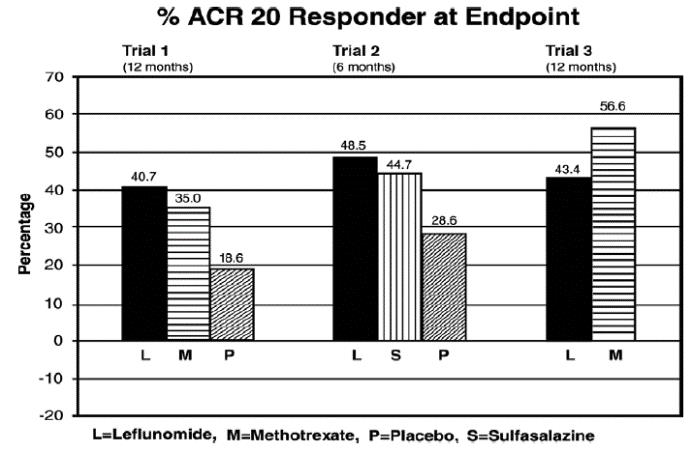
Comparisons 95%Confidence Interval p Value Trial 1 Leflunomide tablets vs. Placebo (12, 32) <0.0001 Methotrexate vs. Placebo (8, 30) <0.0001 Leflunomide tablets vs. Methotrexate (-4, 16) NS Trial 2 Leflunomide tablets vs. Placebo (7, 33) 0.0026 Sulfasalazine vs. Placebo (4, 29) 0.0121 Leflunomide tablets vs. Sulfasalazine (-8, 16) NS Trial 3 Leflunomide tablets vs. Methotrexate (-19, -7) <0.0001 Figure 2. ACR20 Responders over Time in Patients with Active RA in Trial 1*
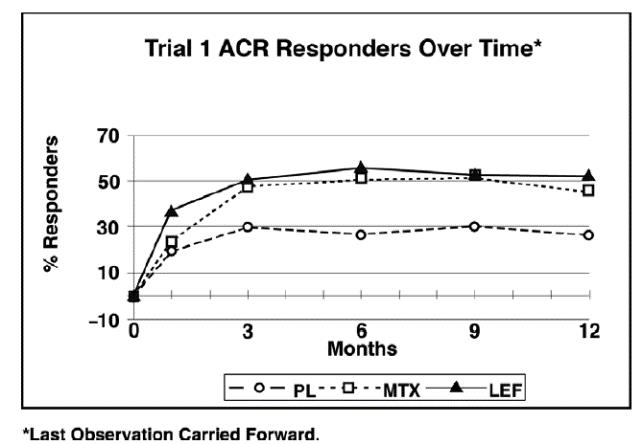
ACR50 and ACR70 Responders are defined in an analogous manner to the ACR 20 Responder, but use improvements of 50% or 70%, respectively (Table 3). Mean change for the individual components of the ACR Responder Index are shown in Table 4.
Table 3. Summary of ACR Response Rates in Patients with Active RA in Trials 1,2, and 3* Study and Treatment Group ACR20 ACR50 ACR70 Placebo-Controlled Studies Trial 1 (12 months) Leflunomide tablets (n=178)† 52‡ 34‡ 20‡ Placebo (n=118) † 26 8 4 Methotrexate (n=180)† 46 23 9 Trial 2 (6 months) Leflunomide tablets (n=130)† 55‡ 33‡ 10§ Placebo (n=91)† 29 14 2 Sulfasalazine (n=132)† 57 30 8 Non-Placebo Active-Controlled Studies Trial 3 (12 months) Leflunomide tablets (n=495)† 51 31 10 Methotrexate (n=489)† 65 44 16 * Intent to treat (ITT) analysis using last observation carried forward (LOCF) technique for patients who discontinued early.
† N is the number of ITT patients for whom adequate data were available to calculate the indicated rates.
‡ p<0.001 Leflunomide tablets vs placebo
§ p<0.02 Leflunomide tablets vs placeboTable 4 shows the results of the components of the ACR response criteria for Trial 1, Trial 2 and Trial 3. Leflunomide tablets was significantly superior to placebo in all components of the ACR Response criteria in study Trial 1 and Trial 2. In addition, leflunomide tablets was significantly superior to placebo in improving morning stiffness, a measure of RA disease activity, not included in the ACR Response criteria. No consistent differences were demonstrated between leflunomide tablets and the active comparators.
Table 4. Mean Change in the Components of the ACR Responder Index in Patients with Active RA in Trials 1, 2, and 3* Components Placebo-Controlled Studies Non-placebo Controlled Study Trial 1 (12 months) Trial 2 Non-US
(6 months)Trial 3 Non-US
(12 months)Leflu nomide Metho trexate Placebo Leflu nomide Sulfa salazine Placebo Leflunomide Methotrexate Tender joint count1 -7.7 -6.6 -3.0 -9.7 -8.1 -4.3 -8.3 -9.7 Swollen joint count1 -5.7 -5.4 -2.9 -7.2 -6.2 -3.4 -6.8 -9.0 Patient global assessment2 -2.1 -1.5 0.1 -2.8 -2.6 -0.9 -2.3 -3.0 Physician global assessment2 -2.8 -2.4 -1.0 -2.7 -2.5 -0.8 -2.3 -3.1 Physical function/disability (MHAQ/HAQ) -0.29 -0.15 0.07 -0.50 -0.29 -0.04 -0.37 -0.44 Pain intensity2 -2.2 -1.7 -0.5 -2.7 -2.0 -0.9 -2.1 -2.9 Erythrocyte Sedimentation rate -6.26 -6.48 2.56 -7.48 -16.56 3.44 -10.12 -22.18 C-reactive protein -0.62 -0.50 0.47 -2.26 -1.19 0.16 -1.86 -2.45 Not included in the ACR Responder Index Morning Stiffness (min) -101.4 -88.7 14.7 -93.0 -42.4 -6.8 -63.7 -86.6 * Last Observation Carried Forward; Negative Change Indicates Improvement
1 Based on 28 joint count
2 Visual Analog Scale - 0=Best; 10=WorstAfter completing 12 months of treatment, patients continuing on study treatment were evaluated for an additional 12 months of double-blind treatment (total treatment period of 2 years) ,. ACR Responder rates at 12 months were maintained over 2 years in most patients continuing a second year of treatment.
Improvement from baseline in the individual components of the ACR responder criteria was also sustained in most patients during the second year of leflunomide tablets treatment in all three trials.
Radiographic Response
The change from baseline to endpoint in progression of structural disease, as measured by the Sharp X-ray score, is displayed in Figure 3. Leflunomide tablets was statistically significantly superior to placebo in inhibiting the progression of disease by the Sharp Score. No consistent differences were demonstrated between leflunomide and methotrexate or between leflunomide and sulfasalazine.
Figure 3. Change in Sharp Score in Patients with Active RA in Trials 1, 2, and 3
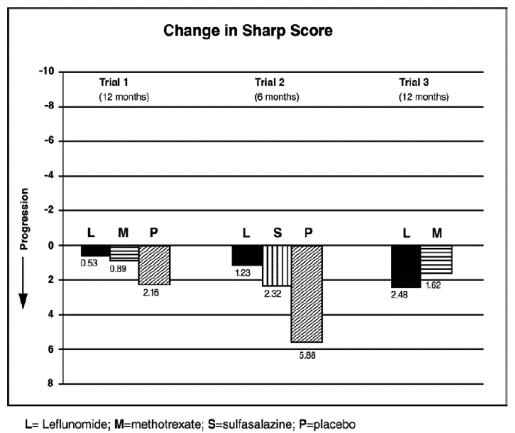
95% Confidence Interval p Value Trial 1 Leflunomide tablets vs. Placebo (-4.0, -1.1) 0.0007 Methotrexate vs. Placebo (-2.6, -0.2) 0.0196 Leflunomide tablets vs. Methotrexate (-2.3, 0.0) 0.0499 Trial 2 Leflunomide tablets vs. Placebo (-6.2, -1.8) 0.0004 Sulfasalazine vs. Placebo (-6.9, 0.0) 0.0484 Leflunomide tablets vs. Sulfasalazine (-3.3, 1.2) NS Trial 3 Leflunomide tablets vs. Methotrexate (-2.2, 7.4) NS The Health Assessment Questionnaire (HAQ) assesses a patient's physical function and degree of disability. The mean change from baseline in functional ability as measured by the HAQ Disability Index (HAQ DI) in the 6 and 12 month placebo and active controlled trials is shown in Figure 4. Leflunomide tablets was statistically significantly superior to placebo in improving physical function. Superiority to placebo was demonstrated consistently across all eight HAQ DI subscales (dressing, arising, eating, walking, hygiene, reach, grip and activities) in both placebo controlled studies.
The Medical Outcomes Survey Short Form 36 (SF-36), a generic health-related quality of life questionnaire, further addresses physical function. In Trial 1, at 12 months, leflunomide tablets provided statistically significant improvements compared to placebo in the Physical Component Summary (PCS) Score.
Figure 4. Change in Functional Ability Measure in Patients with Active RA in Trials 1, 2, and 3*
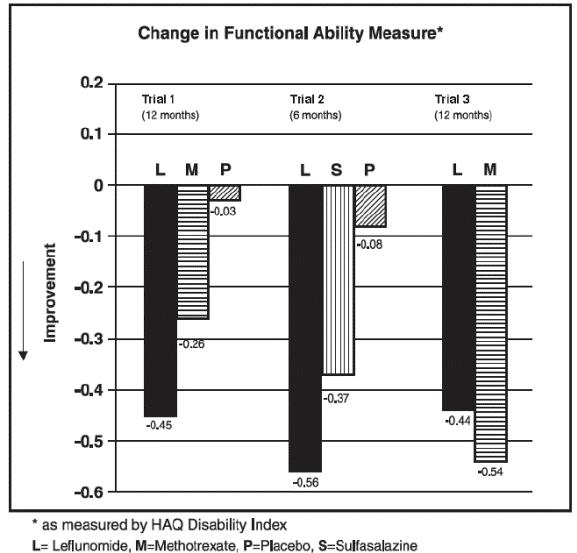
Comparison 95% Confidence Interval p Value Trial 1 Leflunomide tablets vs. Placebo (-0.58, -0.29) 0.0001 Leflunomide tablets vs. Methotrexate (-0.34, -0.07) 0.0026 Trial 2 Leflunomide tablets vs. Placebo (-0.67, -0.36) <0.0001 Leflunomide tablets vs. Sulfasalazine (-0.33, -0.03) 0.0163 Trial 3 Leflunomide tablets vs. Methotrexate (0.01, 0.16) 0.0221 The improvement in physical function demonstrated at 6 and 12 months was maintained over two years. In those patients continuing therapy for a second year, this improvement in physical function as measured by HAQ and SF-36 (PCS) was maintained.
-
16 HOW SUPPLIED/STORAGE AND HANDLING
Leflunomide tablets USP; 10 mg and 20 mg
Strength Quantity NDC Number Description 10 mg 30 count bottle packed in a monocarton 70748-129-06 White to off-white, round film coated tablet, debossed with "L" on one side and "A4" on the other side. 20 mg 30 count bottle packed in a monocarton 70748-130-06 Yellow colour, film coated, round shaped tablet, debossed with "L" on one side and "A5" on the other side. Store at 20°C to 25°C (68°F to 77°F); excursions permitted to 15°C to 30°C (59°F to 86°F) [see USP Controlled Room Temperature]. Protect from light.
-
17 PATIENT COUNSELING INFORMATION
Advise females of reproductive potential
- Of the potential for fetal harm if leflunomide tablets are taken during pregnancy.
- To notify their healthcare provider immediately if a pregnancy occurs or is suspected.
- To use effective contraception during treatment with leflunomide tablets and until the active metabolite (teriflunomide) plasma concentration is verified to be less than 0.02 mg/L [see Warnings and Precautions (5.1,5.3), Use in Specific Populations (8.1,8.3), Clinical Pharmacology (12.3)].
Lactation
Advise nursing women to discontinue breastfeeding during treatment with leflunomide tablets [see Use in Specific Populations (8.2)].
Advise patients of the possibility of rare, serious skin reactions. Instruct patients to promptly report if they develop a skin rash or mucous membrane lesions.
Advise patients of the potential hepatotoxic effects of leflunomide tablets and of the need for monitoring liver enzymes. Instruct patients to report if they develop symptoms such as unusual tiredness, abdominal pain or jaundice.
Advise patients that they may develop a lowering of their blood counts and should have frequent hematologic monitoring. This is particularly important for patients who are receiving other immunosuppressive therapy concurrently with leflunomide tablets, who have recently discontinued such therapy before starting treatment with leflunomide tablets, or who have had a history of a significant hematologic abnormality. Instruct patients to promptly report if they notice symptoms consistent with pancytopenia, such as easy bruising or bleeding, recurrent infections, fever, paleness or unusual tiredness.
Inform patients about the early warning signs of interstitial lung disease and ask to promptly if these symptoms appear or worsen during therapy.
- SPL UNCLASSIFIED SECTION
- Active ingredient
- Purpose
- Uses
-
Warnings
For external use only
Allergy alert: Diclofenac may cause a severe allergic reaction, especially in people allergic to aspirin.
Symptoms may include:
- •
- hives
- •
- asthma (wheezing)
- •
- skin reddening
- •
- blisters
- •
- facial swelling
- •
- shock
- •
- rash
If an allergic reaction occurs, stop use and seek medical help right away.
Liver warning: This product contains diclofenac. Liver damage may occur if you apply
- •
- more or for a longer time than directed
- •
- when using other drugs containing diclofenac
Stomach bleeding warning: This product contains an NSAID, which may cause severe stomach bleeding. The chance is small but higher if you
- •
- are age 60 or older
- •
- have had stomach ulcers or bleeding problems
- •
- take a blood thinning (anticoagulant) or steroid drug
- •
- take other drugs containing prescription or nonprescription NSAIDs (aspirin, ibuprofen, naproxen, or others)
- •
- have 3 or more alcoholic drinks every day while using this product
- •
- apply more or for longer than directed
Heart attack and stroke warning: NSAIDs, except aspirin, increase the risk of heart attack, heart failure, and stroke. These can be fatal. The risk is higher if you use more than directed or for longer than directed.
Do not use
- •
- if you have ever had an allergic reaction to any other pain reliever or to a fever reducer
- •
- for strains, sprains, bruises or sports injuries. This product has not been shown to work for these types of injuries.
- •
- right before or after heart surgery
- •
- on more than 2 body areas at the same time
- •
- in the eyes, nose or mouth
Ask a doctor before use if
- •
- you have problems or serious side effects from taking pain relievers or fever reducers
- •
- stomach bleeding warning applies to you
- •
- you have a history of stomach problems, such as heartburn
- •
- you have high blood pressure, heart disease, liver cirrhosis, kidney disease, asthma, or had a stroke
- •
- you are taking a diuretic
- •
- you are under age 18 years. It is not known if this drug works or is safe in children under age 18 years.
Ask a doctor or pharmacist before use if you are
- •
- under a doctor’s care for any serious condition
- •
- taking any other drug
When using this product
- •
- avoid contact with eyes, nose, or mouth
- •
- if eye contact occurs, rinse thoroughly with water
Stop use and ask a doctor if
- •
- pain gets worse or lasts more than 21 days
- •
- redness or swelling is present in the painful area
- •
- fever occurs
- •
- skin irritation occurs
- •
- any new symptoms appear. These could be signs of a serious condition.
- •
- you experience any of the following signs of stomach bleeding:
- •
- feel faint
- •
- have bloody or black stools
- •
- vomit blood
- •
- have stomach pain that does not get better
- •
- you have symptoms of heart problems or stroke:
- •
- chest pain
- •
- trouble breathing
- •
- leg swelling
- •
- weakness in one part or side of body
- •
- slurred speech
-
Directions
Use up to 21 days unless directed by your doctor
Not for strains, sprains, bruises or sports injuries. This product has not been shown to work for these types of injuries.
Daily
Per Dose
For your arthritis pain:
- •
- Use 4 times per day every day
- •
- Do not use on more than 2 body areas at the same time
Use ENCLOSED DOSING CARD to measure a dose
- •
- For each upper body area (hand, wrist, or elbow) – Squeeze out 2.25 inches (2 grams)
- •
- For each lower body area (foot, ankle or knee) –Squeeze out 4.5 inches (4 grams)
Read the enclosed User Guide for complete instructions:
- •
- use only as directed
- •
- do not use more than directed or for longer than directed
- •
- apply only to clean, dry skin that does not have any cuts, open wounds, infections or rashes
- •
- do not apply in same area as any other product
- •
- do not apply with external heat such as heating pad
- •
- do not apply a bandage over the treated area
- •
- store ENCLOSED DOSING CARD with your Diclofenac Sodium Topical Gel, 1% product. The dosing card is re-usable.
- Other information
- Inactive ingredients
- Questions or comments?
-
Diclofenac Sodium Topical Gel, 1% (NSAID)
Arthritis Pain Reliever
User Guide
How to use Diclofenac Sodium Topical Gel, 1% with answers to frequently asked questions
Quick Start
How to get started right away with Diclofenac Sodium Topical Gel, 1%
Understanding Diclofenac Sodium Topical Gel, 1%
Diclofenac Sodium Topical Gel, 1% (NSAID) – arthritis pain reliever is an arthritis pain relief medication that you apply to your skin.
Before You Use Diclofenac Sodium Topical Gel, 1%
Read the Drug Facts Label, which appears on the carton.
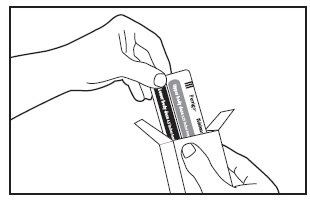
Remove the dosing card from the inside of the carton. You should always use the dosing card to measure out the correct dose of Diclofenac Sodium Topical Gel, 1%.
The first time you use a tube of Diclofenac Sodium Topical Gel, 1%:
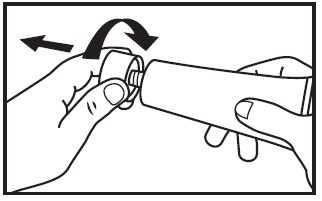
1. Take the cap off the tube.
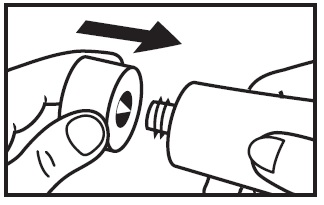
2. Open the safety seal by firmly pressing the point on the top of the cap onto the seal on the tube. Do not open the safety seal with scissors or other sharp objects.
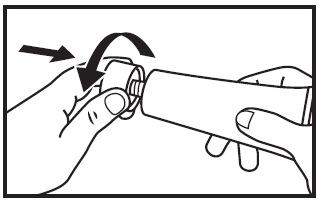
3. After use, put the cap back on the end of the tube.
Using Diclofenac Sodium Topical Gel, 1%
How often to use Diclofenac Sodium Topical Gel, 1%
Use 4 times a day for best results.
For example:

Where to apply Diclofenac Sodium Topical Gel, 1%
Diclofenac Sodium Topical Gel, 1% can be used on up to 2 body areas from the following list: a hand, a wrist, an elbow, a foot, an ankle, a knee. Do not use on more than 2 body areas at once.
Some examples include:
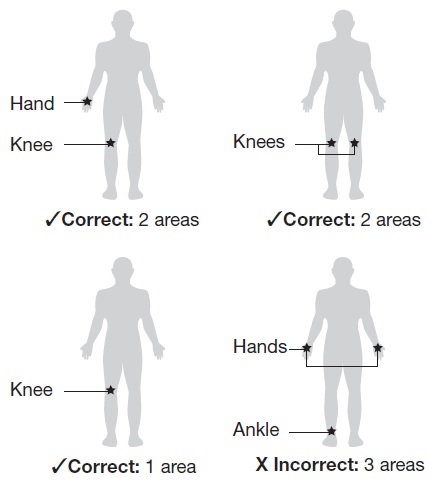
Measuring the correct amount using the dosing card

For each upper body area (a hand, a wrist, or an elbow): Squeeze gel from the tube equal to the length shown on the upper body section of the dosing card (2.25 inches).
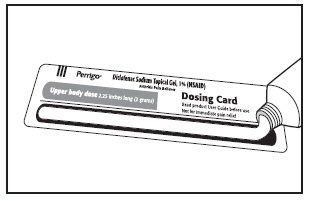
For each lower body area (a foot, an ankle, or a knee): Squeeze gel from the tube equal to the length shown on the lower body section of the dosing card (4.5 inches).
Lost Your Dosing Card? Don’t worry!
Call 1-800-719-9260 to get a free replacement.
Applying Diclofenac Sodium Topical Gel, 1%
Gently rub Diclofenac Sodium Topical Gel, 1% into the skin using your hand. Apply 4 times a day for best results. Do not use on more than 2 body areas at once.
Apply only to clean, dry skin that doesn’t have any cuts, open wounds, infections or rashes. Do not apply in the same area as any other medicines or products that are applied to the skin.
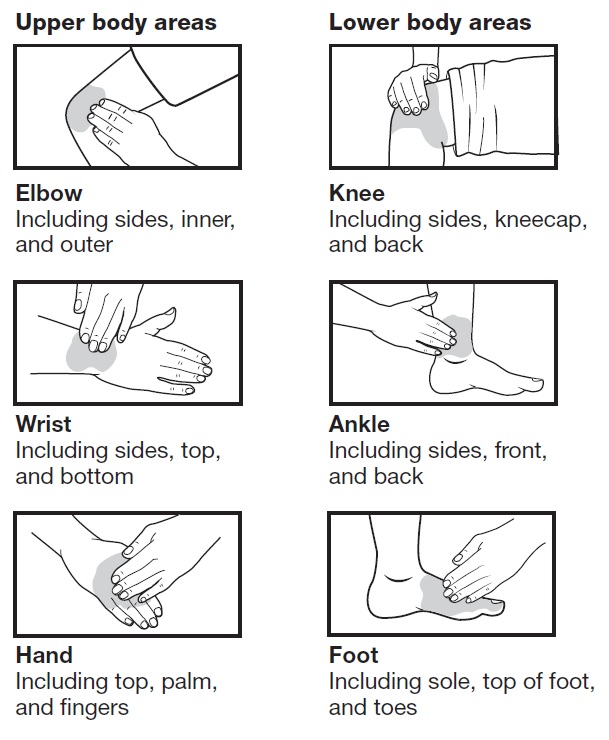
After You Use Diclofenac Sodium Topical Gel, 1%
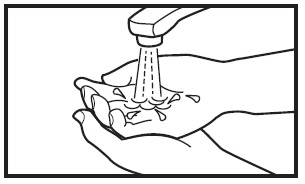
Wash your hands after applying Diclofenac Sodium Topical Gel, 1%. If the treated area is the hands wait up to 1 hour to wash the hands.

Wash the dosing card with water. Store dosing card with your Diclofenac Sodium Topical Gel, 1% and keep out of reach of children.

Wait ten minutes before covering the treated areas with clothes or gloves.
Avoid:
•showering or bathing for at least 1 hour after use•exposing the treated area to sunlight or artificial light (such as in tanning booths)•use in same area as other products applied to the skin•applying a bandage over the treated area•eye, nose, or mouth contact•if eye contact occurs, rinse thoroughly with water
Facts you need to know
Important information about Diclofenac Sodium Topical Gel, 1%
Do not use Diclofenac Sodium Topical Gel, 1%...
•if you have ever had an allergic reaction to any other pain reliever or to a fever reducer•for strains, sprains, bruises or sports injuries. This product has not been shown to work for these types of injuries.•right before or after heart surgery•on more than 2 body areas at the same time•in the eyes, nose or mouth
Ask a doctor before use if...
•you have problems or serious side effects from taking pain relievers or fever reducers•stomach bleeding warning applies to you•you have a history of stomach problems such as heartburn•you have high blood pressure, heart disease, liver cirrhosis, kidney disease, asthma, or had a stroke•you are taking a diuretic•you are under age 18 years. It is not known if this drug works or is safe in children under age 18 years.
Ask a doctor or pharmacist before use if...
•you are under a doctor’s care for any serious condition•you are taking any other drug•you are pregnant or breast-feeding
It is especially important not to use this product during the last 3 months of pregnancy unless definitely directed to do so by a doctor because it may cause problems in the unborn child or complications during delivery.
Warnings to consider before use...
Allergy alert
Diclofenac may cause a severe allergic reaction, especially in people allergic to aspirin. Symptoms may include:
•hives•blisters•asthma (wheezing)•facial swelling•skin reddening•shock•rash
If an allergic reaction occurs, stop use and seek medical help right away.
Liver warning
This product contains diclofenac. Liver damage may occur if you apply
•more or for a longer time than directed•when using other drugs containing diclofenac
Stomach bleeding warning
This product contains an NSAID, which may cause stomach bleeding. The chance is small but higher if you
•are age 60 or older•have had stomach ulcers or bleeding problems•take a blood thinning (anticoagulant) or steroid drug•take other drugs containing prescription or nonprescription NSAIDs (aspirin, ibuprofen, naproxen, or others)•have 3 or more alcoholic drinks every day while using this product•apply more or for longer than directed
Heart attack and stroke warning
NSAIDs, except aspirin, increase the risk of heart attack, heart failure, and stroke. This can be fatal. The risk is higher if you use more than directed or for longer than directed.
Follow these important guidelines when using Diclofenac Sodium Topical Gel, 1%...
•use only as directed•apply only to clean, dry skin that does not have any cuts, open wounds, infections or rashes•do not apply in the same area as any other product used on the skin•do not apply with external heat such as heating pad•do not apply a bandage over the treated area•do not get gel in eyes, nose or mouth•store ENCLOSED DOSING CARD with your Diclofenac Sodium Topical Gel, 1%. The dosing card is re-usable.
Keep out of reach of children.
If swallowed, get medical help or contact a Poison Control Center right away (1-800-222-1222).
Stop using Diclofenac Sodium Topical Gel, 1% and ask a doctor if...
•pain gets worse or lasts more than 21 days•redness or swelling is present in the painful area•fever occurs•skin irritation occurs•any new symptoms appear. These could be signs of a serious condition.•you experience any of the following signs of stomach bleeding:•feel faint•have bloody or black stools•vomit blood•have stomach pain that does not get better•you have symptoms of heart problems or stroke:•chest pain•trouble breathing•leg swelling•weakness in one part of side of body•slurred speech
Questions and Answers
Answers to questions you may ask about Diclofenac Sodium Topical Gel, 1%
Can I use Diclofenac Sodium Topical Gel, 1% for the immediate relief of pain like that associated with sprains, strains, bruises, or sports injuries?
No.
Do not use for strains, sprains, bruises, or sports injuries. This product has not been shown to work for these types of injuries. It’s intended only for the temporary relief of arthritis pain.
How quickly will Diclofenac Sodium Topical Gel, 1% work for arthritis pain?
Diclofenac Sodium Topical Gel, 1% may take up to 7 days to work for your arthritis pain; it is not for immediate relief. With 4 times-a-day use, you may start to feel relief within a few days. You should feel significant pain relief within 7 days of continuous use. If no pain relief in 7 days, stop use.
What is Diclofenac Sodium Topical Gel, 1% used for?
Diclofenac Sodium Topical Gel, 1% can be used for the temporary relief of arthritis pain in the hands, wrists, elbows, feet, ankles, and knees. Osteoarthritis (OA) is the most common form of arthritis. It mainly affects a type of tissue called cartilage, which cushions the joints and prevents the bones from rubbing against each other.
With OA, cartilage begins to break down and wear away, resulting in joint pain and stiffness. OA occurs more frequently as you get older. Pain develops slowly and can gradually worsen over time.
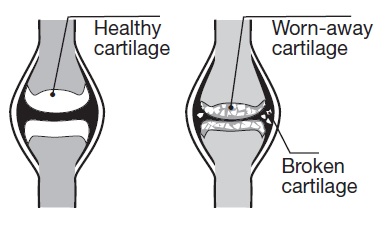
How does Diclofenac Sodium Topical Gel, 1% work?
Diclofenac sodium, the medicine in Diclofenac Sodium Topical Gel, 1%, is a nonsteroidal anti-inflammatory drug (NSAID). NSAIDs are used to treat pain from medical conditions such as arthritis. Diclofenac Sodium Topical Gel, 1% works similarly to oral NSAIDs like ibuprofen or naproxen by temporarily blocking the production of pain signaling chemicals called prostaglandins. However, when taking a pill, the medication is distributed to the site of pain through the bloodstream. Compared to oral diclofenac, only 6% of the medicine in Diclofenac Sodium Topical Gel, 1% is absorbed in the bloodstream. It works by penetrating through your skin at the application site to deliver arthritis pain relief.
How does over-the-counter Diclofenac Sodium Topical Gel, 1% differ from prescription Diclofenac Sodium Topical Gel, 1%?
Over-the-counter Diclofenac Sodium Topical Gel, 1% is the same strength and formula as original full prescription strength Diclofenac Sodium Topical Gel, 1% but is available without a prescription.
Apply Diclofenac Sodium Topical Gel, 1% 4 times a day to ensure you get the full effect of the medicine.
Can I apply Diclofenac Sodium Topical Gel, 1% to upper and lower body areas at the same time?
Yes.
You can use Diclofenac Sodium Topical Gel, 1% on up to 2 body areas at the same time. The areas can include the foot, ankle, knee, hand, wrist, and elbow.
Some correct examples include:
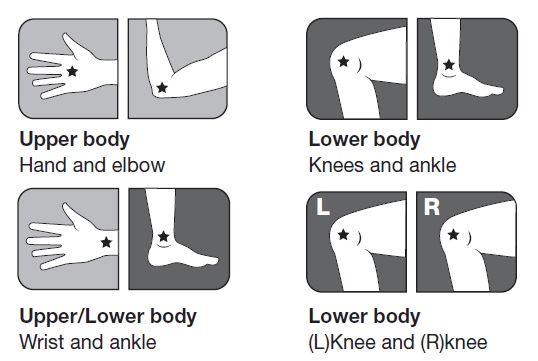
Do not use Diclofenac Sodium Topical Gel, 1% on more than 2 body areas at once.
Can I apply Diclofenac Sodium Topical Gel, 1% without measuring it out on the dosing card first?
No.
Use the dosing card to make sure you are getting the correct amount of medicine.
Can I use Diclofenac Sodium Topical Gel, 1% on my spine, hips, or shoulders?
No.
The use of Diclofenac Sodium Topical Gel, 1% on the spine, hips, and shoulders has not been studied.
Can I take any other pain medications with Diclofenac Sodium Topical Gel, 1%?
Ask your doctor or pharmacist before using Diclofenac Sodium Topical Gel, 1% if you are taking any other pain reliever or are planning on taking any other pain reliever, especially prescription or nonprescription NSAIDs (aspirin, ibuprofen, naproxen, or others).
Can I take any other pain medications during the first 7 days I use Diclofenac Sodium Topical Gel, 1%?
Taking other pain medications is generally not recommended. Speak with your doctor or pharmacist before taking other pain medications when using Diclofenac Sodium Topical Gel, 1%.
How long can I use Diclofenac Sodium Topical Gel, 1%?
Use Diclofenac Sodium Topical Gel, 1% 4 times a day every day for up to 21 days for treatment of arthritis pain or as directed by your doctor.
Diclofenac Sodium Topical Gel, 1% should be part of an overall program for managing your arthritis pain. The program should also include activities such as appropriate movement or exercise, specific lifestyle changes, and weight maintenance. Regular visits and discussions with your doctor can help incorporate Diclofenac Sodium Topical Gel, 1% into a complete program to help manage your arthritis pain.
What do I do if I get Diclofenac Sodium Topical Gel, 1% in my eyes?
If eye contact occurs, rinse thoroughly with water and consult a doctor if irritation lasts more than an hour.
How do I clean the dosing card?
Wash the dosing card with water, and store dosing card and tube out of reach of children.
What if I miss a dose of Diclofenac Sodium Topical Gel, 1%?
If you forget to apply Diclofenac Sodium Topical Gel, 1% don’t double your dose. Just apply the next dose as scheduled.
How should I store Diclofenac Sodium Topical Gel, 1%?
•Store at 20-25°C (68-77°F).•Do not freeze Diclofenac Sodium Topical Gel, 1%.•Store the dosing card with your Diclofenac Sodium Topical Gel, 1%.•Keep out of reach of children.
Additional Questions?
Call 1-800-719-9260.
Made in Israel
Distributed By
Perrigo®
Allegan, MI 49010
87A00 00 J1
- Lefluniclo Packaging
-
INGREDIENTS AND APPEARANCE
LEFLUNICLO
leflunomide and diclofenac sodium gel kitProduct Information Product Type HUMAN PRESCRIPTION DRUG Item Code (Source) NDC:72835-602 Packaging # Item Code Package Description Marketing Start Date Marketing End Date 1 NDC:72835-602-02 1 in 1 CARTON 01/11/2023 Quantity of Parts Part # Package Quantity Total Product Quantity Part 1 1 BOTTLE 30 Part 2 1 TUBE 100 g Part 1 of 2 LEFLUNOMIDE
leflunomide tablet, film coatedProduct Information Item Code (Source) NDC:70748-130 Route of Administration ORAL Active Ingredient/Active Moiety Ingredient Name Basis of Strength Strength LEFLUNOMIDE (UNII: G162GK9U4W) (LEFLUNOMIDE - UNII:G162GK9U4W) LEFLUNOMIDE 20 mg Inactive Ingredients Ingredient Name Strength CROSPOVIDONE (15 MPA.S AT 5%) (UNII: 68401960MK) HYPROMELLOSE 2910 (5 MPA.S) (UNII: R75537T0T4) HYPROMELLOSE 2910 (6 MPA.S) (UNII: 0WZ8WG20P6) LACTOSE MONOHYDRATE (UNII: EWQ57Q8I5X) MAGNESIUM STEARATE (UNII: 70097M6I30) POLYETHYLENE GLYCOL 6000 (UNII: 30IQX730WE) SILICON DIOXIDE (UNII: ETJ7Z6XBU4) STARCH, CORN (UNII: O8232NY3SJ) TALC (UNII: 7SEV7J4R1U) TITANIUM DIOXIDE (UNII: 15FIX9V2JP) Product Characteristics Color yellow Score no score Shape ROUND Size 7mm Flavor Imprint Code L;A5 Contains Packaging # Item Code Package Description Marketing Start Date Marketing End Date 1 NDC:70748-130-06 1 in 1 CARTON 1 30 in 1 BOTTLE; Type 0: Not a Combination Product Marketing Information Marketing Category Application Number or Monograph Citation Marketing Start Date Marketing End Date ANDA ANDA211863 08/31/2020 Part 2 of 2 GOOD SENSE ARTHRITIS PAIN
diclofenac sodium gelProduct Information Item Code (Source) NDC:0113-1189 Route of Administration TOPICAL Active Ingredient/Active Moiety Ingredient Name Basis of Strength Strength DICLOFENAC SODIUM (UNII: QTG126297Q) (DICLOFENAC - UNII:144O8QL0L1) DICLOFENAC SODIUM 10 mg in 1 g Inactive Ingredients Ingredient Name Strength CARBOMER HOMOPOLYMER TYPE C (ALLYL PENTAERYTHRITOL CROSSLINKED) (UNII: 4Q93RCW27E) COCO-CAPRYLATE/CAPRATE (UNII: 8D9H4QU99H) ISOPROPYL ALCOHOL (UNII: ND2M416302) MINERAL OIL (UNII: T5L8T28FGP) POLYOXYL 20 CETOSTEARYL ETHER (UNII: YRC528SWUY) PROPYLENE GLYCOL (UNII: 6DC9Q167V3) WATER (UNII: 059QF0KO0R) Packaging # Item Code Package Description Marketing Start Date Marketing End Date 1 NDC:0113-1189-01 100 g in 1 TUBE; Type 0: Not a Combination Product Marketing Information Marketing Category Application Number or Monograph Citation Marketing Start Date Marketing End Date ANDA ANDA211253 08/22/2020 Marketing Information Marketing Category Application Number or Monograph Citation Marketing Start Date Marketing End Date unapproved drug other 01/11/2023 Labeler - V2 Pharma, LLC (102457346) Establishment Name Address ID/FEI Business Operations LUPIN LIMITED 650582310 manufacture(70748-130) , pack(70748-130) Establishment Name Address ID/FEI Business Operations L. Perrigo Company 006013346 label(0113-1189) Establishment Name Address ID/FEI Business Operations V2 Pharma, LLC 102457346 label(72835-602)

